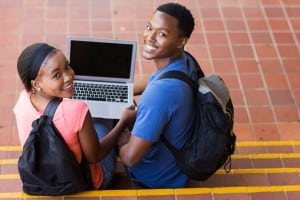What Is Blended Learning?
Education Domain Blog
 How do we empower educators to personalize instruction for each student’s needs? We recognize that it’s very difficult to differentiate instruction for 25 students in a single classroom using a single textbook. The advent of advanced learning technologies empowers teachers to personalize instruction in ways never before possible. Teachers are at the heart of the revolution in education and designing new powerful, personalized learning experiences for students. Empowered with tools to help them succeed, teachers can expand access to digital content resources, pinpoint specific gaps in student learning, identify where a student is on their learning pathway, and provide the appropriate interventions to support students at just the right time.
How do we empower educators to personalize instruction for each student’s needs? We recognize that it’s very difficult to differentiate instruction for 25 students in a single classroom using a single textbook. The advent of advanced learning technologies empowers teachers to personalize instruction in ways never before possible. Teachers are at the heart of the revolution in education and designing new powerful, personalized learning experiences for students. Empowered with tools to help them succeed, teachers can expand access to digital content resources, pinpoint specific gaps in student learning, identify where a student is on their learning pathway, and provide the appropriate interventions to support students at just the right time.
Thus, blended learning is about empowering educators with the appropriate tools to support personalized pathways for learning. For example, the tools in blended learning environments can support flexible pacing, differentiated instruction, immediate interventions and anytime, everywhere learning. Blended learning enables personalized learning at scale, helps foster student-centered instructional approaches and facilitates student co-design with their teachers of how to approach meeting their learning goals.
Defining Blended Learning
According to Horn and Staker, blended learning is:
“Any time a student learns, at least in part, at a supervised brick-and-mortar location away from home and, at least in part, through online delivery with some element of student control over time, place, path, and/or pace. The modalities along each student’s learning path within a course or subject are connected to provide an integrated learning experience.”
The most important component of the definition is the “element of student control” emphasizing the shifting instructional models to enable increased student-centered learning, giving students increased control over the time, place, path, and/or pace of their learning pathways.
Blended learning offers a rational approach, focused on redesigning instructional models first, then applying technology, not as the driver but as the enabler, for high-quality learning experiences that allow a teacher to personalize and maximize learning.
How It Works
In blended learning environments, the educator optimizes learning for students by assessing progress and providing instruction with focused supports. In these models, students are supported and interventions are wrapped around student-centered instructional models at every point throughout the learning trajectories. All of these things can be done in a traditional brick-and-mortar classroom, but one of the great benefits of blended learning is that the technology helps to provide teachers with data, expand student choices for educational resources and learning materials, and provide opportunities for students to practice and to demonstrate high levels of performance.
Blended learning isn’t about layering technology on old instructional models; rather, it is about empowering educators to better understand how to support and differentiate instruction for kids and make their learning experiences engaging and meaningful.
How Blended Learning Drives Personalization
Blended learning instructional designs leverage the strengths of both the classroom and online modalities. The instructional shifts can optimize learning to create more personalized learning opportunities.
For blended learning modalities to drive personalized learning, teachers and students in the blended environment should:
- Understand the student’s experience and what level the student’s proficiency is upon entry;
- Enable an entire range of learning experiences and student services and supports for anytime, everywhere learning;
- Expand and reshape the role of the educator; and
- Determine the student’s progression upon mastery, allowing them to move on when ready.
Key Questions to Ask about Blended Learning
When examining or considering a blended learning program, below are key questions to ask:
- To what extent does the blended learning environment offer transformed instructional design models that provide for optimizing personalized learning in a classroom or in a school?
- Does each student have an individual student profile of their history and performance over time?
- Do blended instructional models include immediate supports and services to students having difficulty demonstrating proficiency or with gaps in knowledge and skills?
- To what extent do the blended learning models provide for multiple pathways to success?
Redesigned instructional models in blended learning enable teachers to provide each and every student with the flexibility for the learner to maximize how, when, where, and what they are learning — aligned to clear learning goals and objectives (academic standards and competencies).
Blended learning offers a way to increase content resources, organize real-time information about the learner’s progress through student profiles and personalized learning plans, and support immediate interventions through differentiated learning strategies. By implementing blended learning in the classroom, districts, schools and teachers can drive personalization for each and every student and prepare them for a lifetime of success.
Learn more about blended learning:
- Clayton Christensen Institute: What Is Blended Learning?
- Report: iNACOL Blended Learning Teacher Competency Framework
- Report: Mean What You Say: Defining and Integrating Personalized, Blended and Competency Education
- Report: Maximizing Competency Education and Blended Learning: Insights from Experts
What does blended learning mean to you? Let us know by responding in the comments below or tweeting to @nacol, or become a guest blogger and tell us about your blended learning journey.